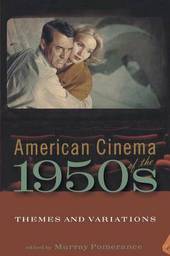
|
American Cinema of the 1950s: Themes and Variations
Paperback / softback
Main Details
| Title |
American Cinema of the 1950s: Themes and Variations
|
| Authors and Contributors |
Edited by Professor Murray Pomerance
|
| Series | Screen Decades |
|---|
| Physical Properties |
| Format:Paperback / softback | | Pages:272 | | Dimensions(mm): Height 234,Width 156 |
|
| Category/Genre | Film theory and criticism
Individual film directors and film-makers |
|---|
| ISBN/Barcode |
9781845204372
|
| Classifications | Dewey:791.430973 |
|---|
| Audience | | Tertiary Education (US: College) | |
|---|
| Illustrations |
33 b&w illustrations, bibliography, index
|
|
Publishing Details |
| Publisher |
Bloomsbury Publishing PLC
|
| Imprint |
Berg Publishers
|
| Publication Date |
1 December 2005 |
| Publication Country |
United Kingdom
|
Description
America in the 1950s was a place of sensational commercial possibility coupled with dark nuclear fears and conformist politics. Cold war hysteria and anti-communist witch hunts influenced a culture already falling under the spell of suburbia, television and a brave new world of luxury goods.Throughout the decade Hollywood was under siege: from the Justice Department pressing for big film companies to divest themselves of their theatre holdings; from the middle classes, whose retreat to family entertainment inside the home drastically decreased the film-going audience; and from the House Un-American Activities Committee, attempting to purge the country of dissenting political views. This tumultuous decade also saw some of Hollywoods most talented filmmakers - John Ford, Alfred Hitchcock, Vincente Minnelli, Nicholas Ray and Billy Wilder - producing some of the best-loved movies in the history of cinema, including From Here to Eternity, Sunset Boulevard., Singin' in the Rain, Shane, Rear Window, and Rebel Without a Cause.
Author Biography
Murray Pomerance is a professor in the Department of Sociology at Ryerson University, which he chairs. He is editor of the Horizons of Cinema series at SUNY Press and co-editor, with Lester D. Friedman, of the Screen Decades series in which this volume appears.
|